Maban languages
Last updated| Maban | |
|---|---|
| Geographic distribution | Chad, Sudan, Central African Republic |
| Linguistic classification | Nilo-Saharan?
|
| Subdivisions | |
| Glottolog | maba1274 |
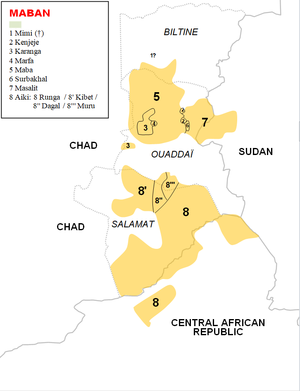 | |
The Maban languages are a small family of languages which have been included in the proposed Nilo-Saharan family. Maban languages are spoken in eastern Chad, the Central African Republic and western Sudan (Darfur).
Contents
Languages
The Maban branch includes the following languages:
- Mimi of Nachtigal
- Kenjeje (Yaali, Faranga)
- Masalit: Surbakhal, Masalit
- Aiki (Runga and Kibet, sometimes considered separate languages)
- Mabang: Karanga, Marfa, Maba
The languages attested in two word lists labelled "Mimi", collected by Decorse (Mimi-D) and Nachtigal (Mimi-N), have also been classified as Maban, though this has been contested. Mimi-N appears to have been remotely related to Maban proper, while Mimi-D appears to have not been Maban at all, with the similarities due to language contact with locally dominant Maba.
Blench (2021) gives the following classification: [1]
External relationships
Based on morphological evidence such as tripartite number marking on nominals, Roger Blench (2021) suggests that closest relatives of the Maban languages may be the Eastern Sudanic languages, especially the Taman languages, which form a branch within Northern Eastern Sudanic. Maban also shares lexical similarities with the Fur languages, Saharan languages, and even Songhay languages, but generally has more lexical matches with Eastern Sudanic languages. [1]
Comparative vocabulary
Blench (2021) posits the following consonants for proto-Maban: [1]
| (p) b | t d | tʃ | k ɡ | |
| s (z) | ʃ | (h) | ||
| m | n | ɲ | ŋ | |
| w | l r | j |
Vowels likely were ATR pairs, with at least *a *ɛ *e *i *ɔ *o *u and possibly *ɪ *ʊ, plus length.
There were likely two register tones plus the possibility of contour tones on long vowels.
Sample basic vocabulary for Maban languages:
| Language | eye | ear | nose | tooth | tongue | mouth | blood | bone | tree | water | eat | name |
|---|---|---|---|---|---|---|---|---|---|---|---|---|
| Proto-Maban [1] | *kàSì-k | *dúrmì | *sati-k; *sàdí-k / *sadi-ɲi | *delemi-k | *fàrí-ŋ | *ta-k / *ta-si | *-aɲɔ- | *mílí-ik | ||||
| Maba [2] | kàʃì-k/-ñi | koi-k | boiñ | sati-k | delmi-k | kan-a/-tu | àríi | kàñjí-k | soŋgo-k | inji | -añ- | mílí-i/-síi |
| Masalit [2] | kóo-gí/-sí | kwóyɛ̀ | dúrmì | kácìŋgi | gélmèdì | kánà | fàríŋ | kónjì | síŋgì | sá | -iny- | mirsi/-ldiŋ |
| Aiki [2] | kàs-`k/-ò | kàsá | mùndú | sàdí | àdìyím | yù-k | pày/-ó; fáai | jìŋg`r/jùŋgɔ̀rɔ̀ | rí-k | tà-k | -ñɔ̀- | mèek-í/-ú |
| Kibet [2] | kàs/-u | kàsá | mùndù | sàdí | àd`lɛ́m | yù-k | fal/-u; ari | njekedi/njùkùdú | ri-k | ta | -ñɔ̀- | m lk-i/-udɔ |
| Mimi of Nachtigal [3] | kal | kuyi | hur | ziːk | mil | ari | kadʒi | sun (< Fur?) | ||||
| Mimi of Decorse [4] | dyo | feɾ | fir | ɲain | ɲyo | su | engi | ɲyam |
Numerals
Comparison of numerals in individual languages: [5]
| Classification | Language | 1 | 2 | 3 | 4 | 5 | 6 | 7 | 8 | 9 | 10 |
|---|---|---|---|---|---|---|---|---|---|---|---|
| Maba | Maba | tɛ́ɡ, tɔ́ː | mbàːr, mbíːr, mbùl | kùŋàːl, káyáŋ | àssàːl, ássíː | tùːr, túːr | sit̀tàːl, síttíː < Arabic sitta | mɛ́ndrìː | íyyáː | ɔ̀ddɔ̀yí | ɔ̀ttúɡ |
| Masalit | Masalit (1) | tíyóŋ | mbárá | káaŋ | áás | tóór | ít̪í | màrí | àd̪á | àyi | ùt̪úk |
| Masalit | Masalit (2) | tîyom (without noun), tîle (with n.) | mbara | kaŋ | as | tur | iti | mâri | aya | adey | ûtuk |
| Masalit | Masalit (3) | tyǒm (without noun), tíiilò (with n.) | mbárá | káaŋ | ás | túr | ítí | màrí | àyá | àdɛ́i | ùtúk |
| Runga-Kibet | Kibet | doˈwai | mbaʀ | kʰasaŋˈɡal | ʔaːtal | tor | ʔiˈsal | mɪndɪrˈsɪʔ | mbaːkʰl | kʰaˈdɛijə | juˈtʊk̚ |
| Runga-Kibet | Runga | kʰanˈda | mba | kʰazaŋɡa | attɛi | tur | izɛi | mɪnˈdirsi | mbɑkadeli | kʰaddɛl | jtuk̚ |
See also
- Maban word lists (Wiktionary)
Related Research Articles

The Chadic languages form a branch of the Afroasiatic language family. They are spoken in parts of the Sahel. They include 150 languages spoken across northern Nigeria, southern Niger, southern Chad, the Central African Republic, and northern Cameroon. By far the most widely spoken Chadic language is Hausa, a lingua franca of much of inland Eastern West Africa, particularly Niger and the northern half of Nigeria.

The Cushitic languages are a branch of the Afroasiatic language family. They are spoken primarily in the Horn of Africa, with minorities speaking Cushitic languages to the north in Egypt and Sudan, and to the south in Kenya and Tanzania. As of 2012, the Cushitic languages with over one million speakers were Oromo, Somali, Beja, Afar, Hadiyya, Kambaata, and Sidama.

The Kordofanian languages are a geographic grouping of five language groups spoken in the Nuba Mountains of the South Kordofan region of Sudan: Talodi–Heiban languages, Lafofa languages, Rashad languages, Katla languages and Kadu languages. The first four groups are sometimes regarded as branches of the hypothetical Niger–Congo family, whereas Kadu is now widely seen as a branch of the proposed Nilo-Saharan family.

The Nilo-Saharan languages are a proposed family of African languages spoken by somewhere around 70 million speakers, mainly in the upper parts of the Chari and Nile rivers, including historic Nubia, north of where the two tributaries of the Nile meet. The languages extend through 17 nations in the northern half of Africa: from Algeria to Benin in the west; from Libya to the Democratic Republic of the Congo in the centre; and from Egypt to Tanzania in the east.

The Songhay, Songhai or Ayneha languages are a group of closely related languages/dialects centred on the middle stretches of the Niger River in the West African countries of Mali, Niger, Benin, Burkina Faso and Nigeria. In particular, they are spoken in the cities of Timbuktu, Djenné, Niamey and Gao. They have been widely used as a lingua franca in that region ever since the era of the Songhai Empire. In Mali, the government has officially adopted the dialect of Gao as the dialect to be used as a medium of primary education.
The Masalit are an ethnic group inhabiting western Sudan and eastern Chad. They speak the Masalit language.
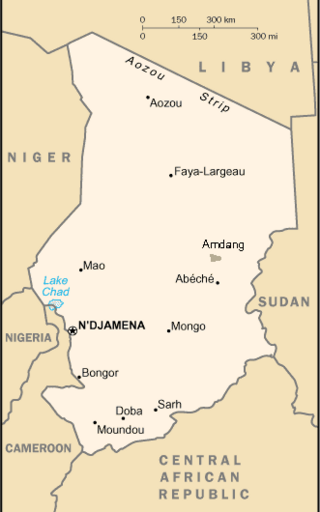
Amdang is a language closely related to Fur, which together constitute a branch of the Nilo-Saharan language family. It is mainly spoken in Chad, north of the town of Biltine, and sporadically elsewhere in Ouaddaï Region. There are also small colonies of speakers in Darfur near Woda'a and Fafa, and in Kordofan in the Abu Daza district and at Magrur north of Bara. Most of the ethnic group now speaks Arabic.
Masalit is a Nilo-Saharan language of the Maban language group spoken by the Masalit people in West Darfur, Sudan and Ouaddaï Region, Chad.

The Nilotic languages are a group of related languages spoken across a wide area between South Sudan and Tanzania by the Nilotic peoples.
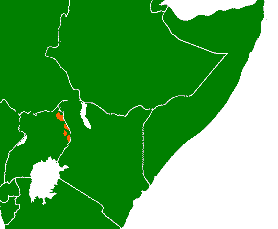
The Kuliak languages, also called the Rub languages, are a group of languages spoken by small relict communities in the mountainous Karamoja region of northeastern Uganda.

In most classifications, the Eastern Sudanic languages are a group of nine families of languages that may constitute a branch of the Nilo-Saharan language family. Eastern Sudanic languages are spoken from southern Egypt to northern Tanzania.
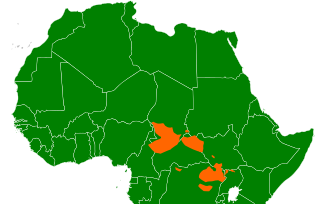
Central Sudanic is a family of about sixty languages that have been included in the proposed Nilo-Saharan language family. Central Sudanic languages are spoken in the Central African Republic, Chad, South Sudan, Uganda, Congo (DRC), Nigeria and Cameroon. They include the pygmy languages Efé and Asoa.
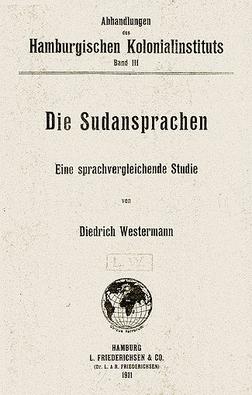
In early 20th century classification of African languages, Sudanic was a generic term for languages spoken in the Sahel belt, from Ethiopia in the east to Senegal in the west.
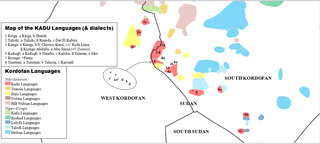
The Kadu languages, also known as Kadugli–Krongo or Tumtum, are a small language family of the Kordofanian geographic grouping, once included in Niger–Congo. However, since Thilo Schadeberg (1981), Kadu is widely seen as Nilo-Saharan. Evidence for a Niger-Congo affiliation is rejected, and a Nilo-Saharan relationship is controversial. A conservative classification would treat the Kadu languages as an independent family.

Chad has two official languages, Arabic and French, and over 120 indigenous languages. A vernacular version of Arabic, Chadian Arabic, is a lingua franca and the language of commerce, spoken by 40–60% of the population. The two official languages have fewer speakers than Chadian Arabic. Standard Arabic is spoken by around 615,000 speakers. French is widely spoken in the main cities such as N'Djamena and by most men in the south of the country. Most schooling is in French. The language with the most first-language speakers is probably Ngambay, with around one million speakers.
The Maba, also called Bargo or Wadai people, are a Sunni Muslim ethnic group found primarily in the mountains of Wadai region in eastern Chad and southern Sudan. Their population is estimated to be about 542,000. Other estimates place the total number of Bargo people in Sudan to be about 25,000.
Migaama is an Afro-Asiatic language spoken in central Chad. Speakers make up the majority of the population of Bang Bang, Chad.
The Komuz languages are a proposed branch of the Nilo-Saharan language family which would include the Koman languages, the Gumuz languages and the Shabo language, all spoken in south-eastern Sudan and western Ethiopia. Nilo-Saharan specialists have vacillated on a genealogical relationship between the Koman and Gumuz languages, a relationship called Komuz. Greenberg (1963) had included Gumuz in the Koman language family. Bender classified them together in a distant relationship he called Komuz, but by 1996 he had reversed himself, though he kept both groups in core Nilo-Saharan. Dimmendaal (2008) kept them together, though expressed doubts over whether they belonged in Nilo-Saharan, later referring to Gumuz as an isolate (2011). Ahland, on the basis of new Gumuz data, resurrected the hypothesis. Blench (2010) independently came to the same conclusion and suggested that the Shabo language might be a third, outlying branch. The classification of Shabo is difficult because of a strong Koman influence on the language that is independent of any genealogical relationship between them. Schnoebelen (2009), moreover, sees Shabo as a likely isolate.
The Northern Eastern Sudanic, Eastern k Sudanic, Ek Sudanic, NNT or Astaboran languages may form a primary division of the proposed Eastern Sudanic family. They are characterised by having a /k/ in the first person singular pronoun "I/me", as opposed to the Southern Eastern Sudanic languages, which have an /n/. Nyima has yet to be conclusively linked to the other languages, and would appear to be the closest relative of Ek Sudanic rather than Ek Sudanic proper.
Shemya is the language of the Sinyar people. It is a Central Sudanic language spoken in Chad and formerly in Darfur, Sudan. It is variously spelled Shamya, Shamyan, Shemya, Sinya, and known as Symiarta, Taar Shamyan, Zimirra.
References
- 1 2 3 4 Blench, Roger. 2021. The Maban languages and their place within Nilo-Saharan .
- 1 2 3 4 Edgar, John T. 1991. Maba-group Lexicon. (Sprache und Oralität in Afrika: Frankfurter Studien zur Afrikanistik, 13.) Berlin: Dietrich Reimer.
- ↑ Lukas, Johannes & Otto Völckers. 1938. G. Nachtigal's Aufzeichnungen über die Sprache der Mimi in Wadai. Zeitschrift für Eingeborenensprachen 29. 145‒154.
- ↑ Gaudefroy-Demombynes, Maurice. 1907. Document sur les Langues de l'Oubangui-Chari. In Actes du XVIe Congrès International des Orientalistes, Alger, 1905, Part II, 172-330. Paris: Ernest Leroux.
- ↑ Chan, Eugene (2019). "The Nilo-Saharan Language Phylum". Numeral Systems of the World's Languages.
- Calvain Mbernodji, Katharina Wolf. 2008. Une enquête sociolinguistique des parlers Kibet, Rounga, Daggal et Mourro du Tchad. SIL International.
Further reading
- Edgar, John T. 1991. Maba-group Lexicon. (Sprache und Oralität in Afrika: Frankfurter Studien zur Afrikanistik, 13.) Berlin: Dietrich Reimer.
- Edgar, John. 1991. First Steps Towards Proto-Maba. African Languages and Cultures 4: 113-133.
External links
- G. Starostin, 2011. On Mimi
Text is available under the CC BY-SA 4.0 license; additional terms may apply.
Images, videos and audio are available under their respective licenses.